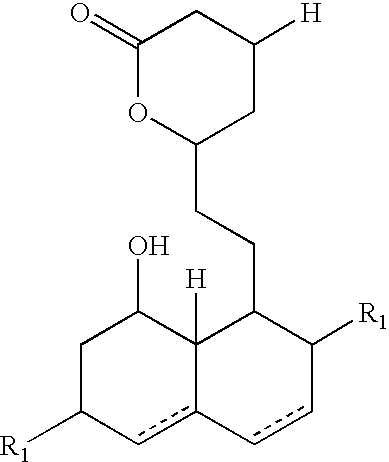New salts of HMG-CoA reductase inhibitors
- Summary
- Abstract
- Description
- Claims
- Application Information
AI Technical Summary
Problems solved by technology
Method used
Image
Examples
example 1
[0064] Preparation of Free Acid of Mevastatin and Conversion thereof into Salt thereof with Tertiary Butylamine (TBA)
[0065] Mevastatin (200 g) was suspended in 30% volume / volume (v / v) aqueous acetonitrile solution (2500 ml), 3 equivalents of triethylamine were added and the mixture was heated to 80.degree. C. and stirred for 30 minutes. After the completed reaction, acetonitrile was evaporated, the remaining solution was acidified to pH 4 with phosphoric acid and extracted into ethyl acetate (2.times.1000 ml). The pooled extracts were dried by the addition of 30 g of sodium sulphate, the desiccant was filtered off and the solution was concentrated (950 ml). TBA (1.5 equivalents) was added to the solution and crystallization was carried out for 30 minutes at 8.degree. C. The crystals formed were filtered and washed with ethyl acetate (2.times.100 ml) and subsequently dried at 40.degree. C. for 15 hours. The crystals obtained (the TBA salts of mevastatin 215 g) were white in color wit...
example 2
[0066] Preparation of the Sodium Salt of Mevastatin from the TBA Salt of Mevastatin
[0067] The TBA salt of mevastatin (1 g), obtained by the process disclosed in example 1, was dissolved in 3 ml of ethanol (96% v / v) and sodium hydroxide (40 g / L of ethanol) was added. The resulting mixture was precipitated in the ethyl acetate (60 ml). After the crystallization (30 min) at 8.degree. C. the crystals were filtered off, washed with ethyl acetate and dried. The product: crystals of the sodium salt of mevastatin (0.65 g) pale brown in color with a HPLC purity of 98%.
example 3
[0068] Isolation of the TBA Salts of Lovastatin from the Fermentation Broth
[0069] A fermentation broth (160 L) obtained by the fermentation with a microorganism Aspergillus terreus ATCC 20544 and having a lovastatin content of 1 g / L was transferred from the fermenter into the tank (400 L) and pH was adjusted to 10 with the addition of 1 M aqueous sodium hydroxide 10 minutes of vigorous stirring the pH of the broth was decreased to 9 by adding 1 M sulphuric acid solution and the biomass was filtered off. The filtrate obtained was acidified to a pH value of 6.5 with 1 M sulphuric acid solution and 160 L of ethyl acetate was added. The slurry was subsequently stirred for 20 minutes. The aqueous and ethyl acetate phases were separated by extraction centrifuge and the ethyl acetate extract was concentrated in a rotavapor to the volume of 14 L. The concentration of lovastatin in the form of free acid in concentrated ethyl acetate extract was 10.1 g / L. To the obtained lovastatin solution (...
PUM
| Property | Measurement | Unit |
|---|---|---|
| Fraction | aaaaa | aaaaa |
| Fraction | aaaaa | aaaaa |
| Fraction | aaaaa | aaaaa |
Abstract
Description
Claims
Application Information
 Login to View More
Login to View More - R&D
- Intellectual Property
- Life Sciences
- Materials
- Tech Scout
- Unparalleled Data Quality
- Higher Quality Content
- 60% Fewer Hallucinations
Browse by: Latest US Patents, China's latest patents, Technical Efficacy Thesaurus, Application Domain, Technology Topic, Popular Technical Reports.
© 2025 PatSnap. All rights reserved.Legal|Privacy policy|Modern Slavery Act Transparency Statement|Sitemap|About US| Contact US: help@patsnap.com



